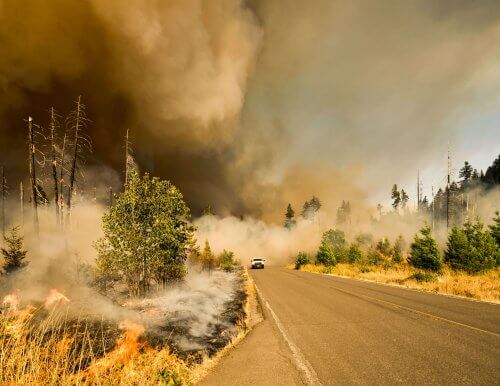
You may be entitled to damages under inverse condemnation if you were injured or your property was damaged due to a California Wildfire. Our legal teams are currently representing clients who suffered losses in the Dixie, Glass, Zogg, Bobcat, Kincade, Mountain View or Woolsey Fires. Call us today at 800-718-4658 for a free consultation.
You must file a lawsuit to recover damages. Our attorneys have extensive experience handling inverse condemnation claims. We can help you determine the extent of your loss and obtain the largest possible recovery for all of your damages.
Inverse Condemnation: Compensation For Damaged Property
The Fifth Amendment to the United States Constitution reads, “nor shall private property be taken for public use, without just compensation.” Inverse condemnation describes a situation where the government takes private property without paying the just compensation guaranteed by the Fifth Amendment, forcing the property owner to file a lawsuit to obtain the compensation. The term also includes property that is damaged instead of taken as well in some states.
The government is the plaintiff who sues a defendant/owner to take the property from them in direct condemnation. The owner is the plaintiff in inverse condemnation and this is why it is called inverse condemnation.
Inverse Condemnation And Utilities In California
Article One, Section 19 of California’s constitution states “Private property may be taken or damaged for a public use and only when just compensation, ascertained by a jury unless waived, has first been paid to, or into court for, the owner.” The California Supreme Court ruled in 1885 that this lets property owners obtain compensation when public improvements cause tangential harm to their property (Reardon v San Francisco (1885) 66 Cal. 492, 501).
Privately-owned utilities in California are granted the ability to condemn private property using eminent domain. The California Supreme Court ruled in 1999 that a private utility was liable for property damage, caused by a wildfire its power lines started, through inverse condemnation, citing the utility’s ability to condemn property through eminent domain while ruling there was no significant difference between publicly owned and privately owned utilities in terms of finding inverse condemnation.
This means that private utilities such as PG&E, and public utilities such as Southern California Edison, can be held liable under inverse condemnation for property damage caused by the wildfires they are responsible for.
Kincade Fire lawsuits represent an example of lawsuits seeking compensation for property damage under the cause of action of inverse condemnation. The Kincade Fire raged in Sonoma County, California from October 23, 2019 to November 6, 2019, burning 77,758 acres of land, destroying 374 buildings, causing four non-fatal injuries and causing the evacuation of around 190,000 people. Lawsuits claim PG&E’s equipment sparked the fire because PG&E failed to properly maintain, inspect, manage or monitor their power lines and equipment as well as vegetation near the equipment in a timely manner.
Lawsuits seek to recover compensation from PG&E for property damaged by the Kincade Fire under inverse condemnation, claiming this recovery is valid because PG&E’s maintenance of their power lines and surrounding vegetation caused the fire.
What Can Be Recovered Under Inverse Condemnation?
Any damage to real property caused by a utility can be recovered under inverse condemnation in California, including:
• The loss of a home
• The loss of outbuildings
• Attorneys’ fees
• Prejudgment interest
If Your Home Was Damaged By A California Wildfire
Call us today at 800-718-4658 if you were injured or sustained property damage from a wildfire caused by a utility company such as PG&E or SoCal Edison. You can also chat with one of our live chat specialists or complete the contact form on this page to request a free consultation.
We only charge clients a portion of their recovery if we obtain a recovery so you will never owe us for our services. No recovery, no fee.

